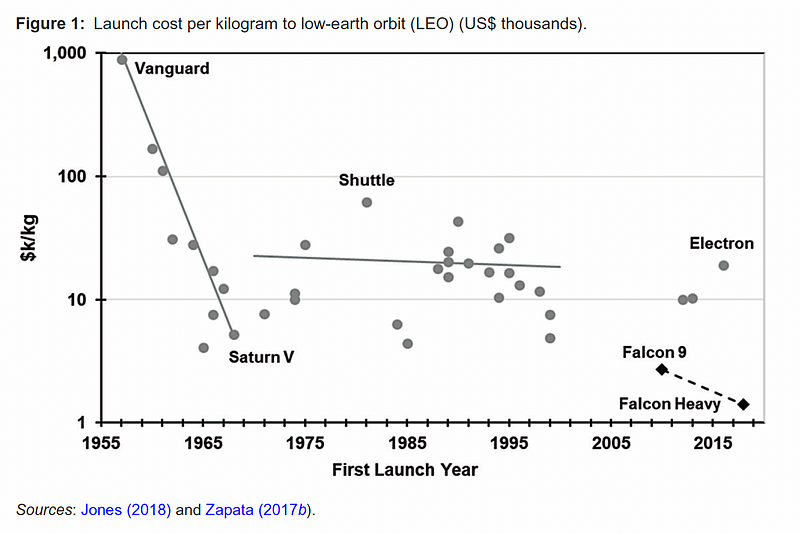SpaceX vs. NASA: Unpacking the Cost Efficiency of Space Launches
Written on
Chapter 1: Introduction to Space Launch Economics
The current landscape of space exploration is increasingly competitive, with new players entering the arena. According to The Economist (18 October 2018), one of the most significant newcomers is SpaceX, which transitioned from an underestimated startup in 2002, founded by Elon Musk, to dominating nearly two-thirds of the global commercial launch market by 2018. SpaceX’s success can be attributed to its innovative platform strategy, which has allowed it to surpass both public and private competitors.
In this report, we will focus on the comparative analysis of NASA and SpaceX across several critical metrics: cost, speed-to-market, schedule adherence, and scalability, using a sample of 203 space missions. This section specifically examines cost.
Section 1.1: Cost Efficiency of SpaceX vs. NASA
The results indicate that SpaceX’s platform approach significantly outperforms NASA’s traditional bespoke strategy, often by substantial margins. It's essential to clarify that this analysis is not intended to demean public sector efforts or to overstate the merits of private enterprises. Instead, it aims to demonstrate that platform-based projects, whether in the public or private sector, consistently yield better outcomes compared to more traditional, quantum-leap projects.
Interestingly, the success of SpaceX is intricately linked to NASA, as the latter is its largest client and beneficiary. Conversely, SpaceX's growth has been fueled by contracts and financial support from NASA. Notably, it was NASA's challenges with its own projects that prompted a shift towards a platform strategy in the mid-2000s, moving away from traditional cost-plus contracts to fixed-price agreements, which distribute risk more equitably between NASA and its contractors.
The first video provides insights into the competitive dynamics between SpaceX and NASA, questioning whether comparisons are fair in the context of their differing operational frameworks.
Section 1.2: Cost per Kilogram to Low-Earth Orbit
When evaluating cost efficiency, we utilize the standard industry metric of cost per kilogram to Low-Earth Orbit (LEO). Data shows that SpaceX’s Falcon Heavy dramatically reduces launch costs. For instance, the Falcon Heavy’s pricing stands at approximately US$1,400 per kilogram, making it 700 times less expensive than NASA's original Vanguard rockets and significantly cheaper than the retired Space Shuttle and the Apollo-era Saturn V.

Moreover, SpaceX's prices for Falcon Heavy launches start around US$90 million, which is nearly five times cheaper than the Delta IV Heavy, created by the United Launch Alliance (ULA), and less than one-third the cost of the Russian Proton rockets, which have been operational since the 1960s.
Chapter 2: Development Costs and Cost Overruns
Continuing with the analysis of development costs, NASA estimated that developing the Falcon 9 rocket under its own management would range between US$1.7 billion and US$4.0 billion, whereas SpaceX achieved this for approximately US$390 million. This figure illustrates that SpaceX’s development expenses are 4 to 10 times lower than NASA’s projections.
The second video analyzes how NASA and SpaceX compare in their operations and project management, focusing on cost efficiency and development strategies.
SpaceX also excels in managing development costs. Historical data from the Apollo program, which included 15 Saturn V rockets, reveals that the U.S. invested US$25.4 billion at 1970s prices—roughly US$150–160 billion today. In contrast, the Space Launch System (SLS) developed by NASA has costs exceeding US$21.2 billion. Meanwhile, SpaceX’s Falcon Heavy has development costs ranging from US$500 to US$750 million, demonstrating its remarkable cost efficiency.
In terms of cost overruns, NASA missions tend to face frequent and significant budget overruns. Of the 181 NASA missions analyzed, 90% experienced cost overruns, while for SpaceX, the figure stands at 50%. The average cost overrun for NASA was +90%, whereas SpaceX maintained a mere +1.1%, indicating a much tighter budget control.
In conclusion, SpaceX operates at a cost efficiency that is ten times lower than NASA's, with significantly reduced cost overruns, making it a formidable player in the realm of space launches.